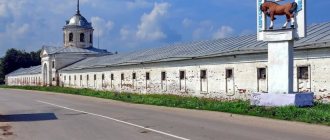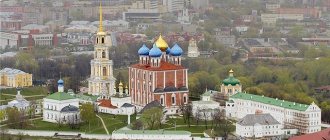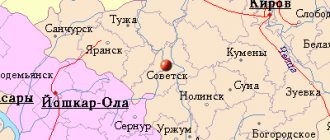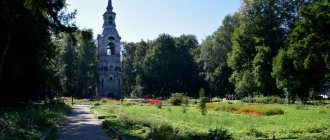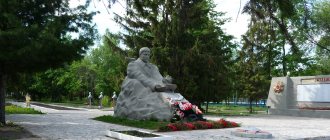For other uses, see Komsomolsk.
Town in Ivanovo Oblast, Russia
| Komsomolsk Komsomolsk | |
| City [1] | |
| Komsomolsk city administration building | |
| Komsomolsk | |
| Komsomolsk Komsomolsk Show map of Russia Komsomolsk Komsomolsk (Ivanovo region) Show map of Ivanovo Oblast | |
| Coordinates: 57°01′34″N 40°22′44″E / 57.02611°N 40.37889°E / 57.02611; 40.37889 Coordinates: 57°01′34″N 40°22′44″E / 57.02611°N 40.37889°E / 57.02611; 40.37889 | |
| A country | Russia |
| Federal subject | Ivanovo region [1] |
| Administrative region | Komsomolsky district [1] |
| Based | 1931 |
| City status from | 1950 |
| Height | 145 m (476 ft) |
| population size (2010 Census) [2] | |
| • General | 8 693 |
| • Evaluate (2018) [3] | 8 189 ( -5,8% ) |
| Administrative status | |
| • Capital from | Komsomolsky district [1] |
| Municipal status | |
| • Municipal district | Komsomolsky municipal district [4] |
| • Urban village | Urban settlement Komsomolskoye [4] |
| • Capital from | Komsomolsky municipal district [4], urban settlement Komsomolskoye [4] |
| Timezone | UTC+3 (MSK[5]) |
| Postal code [6] | 155150 |
| OKTMO ID | 24613101001 |
| Web site | web.archive.org/web/20140104045154/http: //komsomolsk37.ru/ |
Komsomol
(Russian: Komsomolsk) is a city and the administrative center of Komsomolsky District in Ivanovo Oblast, Russia, located on the Ukhtokhma River (Uvodsky's tributary) 34 km (21 mi) west of Ivanovo, the administrative center of the region. Population: 8,693 (2010 census); [2] 9,595 (2002 census); [7] 11,587 people (1989 census).[8]
Administrative and municipal status[edit]
As part of the administrative divisions, Komsomolsky serves as the administrative center of the Komsomolsky District, to which it is directly subordinate. [1] Before the adoption of Law No. 145-OZ “ On the administrative-territorial division of the Ivanovo region”
in December 2010 it was separately formed as an administrative unit with a status equal to that of districts. [9]
In the municipal division, the city of Komsomolsk is included in the Komsomolsky municipal district in the Komsomolsky urban settlement
. [4]
Links[edit]
Notes[edit]
- ^ abcde Law No. 145-OZ
- ^ a b Federal State Statistics Service (2011). “All-Russian Population Census 2010. Volume 1" [All-Russian Population Census 2010, vol. 1]. All-Russian Population Census 2010 [All-Russian Population Census 2010]
. Federal State Statistics Service. - "26. The size of the permanent population of the Russian Federation by municipalities as of January 1, 2022". Federal State Statistics Service. Retrieved January 23, 2022.
- ^ abcde Law No. 43-OZ
- "On the Calculation of Time". Official Internet portal of legal information
. June 3, 2011. Retrieved January 19, 2022. - Post office. Information and computing center of OASU RPO. ( Post office
).
Search for postal service objects ( postal Search for objects
) (in Russian) - ↑
Federal State Statistics Service of Russia (May 21, 2004).
“The population of Russia, the constituent entities of the Russian Federation as part of federal districts, urban settlements, settlements, settlements is 3 thousand or more people” [Population of Russia, its federal districts, federal districts, districts Urban settlements, rural settlements - administrative centers and rural settlements with a population of over 3,000] (XLS). All-Russian Population Census 2002
. - “All-Union Population Census of 1989. The current population of union and autonomous republics, autonomous regions and districts, territories, negative phenomena, urban settlements and rural district centers” [All-Union Population Census of 1989: current population of union and autonomous republics, Autonomous regions and districts , territories, regions, districts, towns and villages performing the functions of district administrative centers. All-Union Population Census of 1989 [All-Union Population Census of 1989]
.
Institute of Demography of the National Research University: Higher School of Economics [Institute of Demography of the National Research University: Higher School of Economics]. 1989 - via Demoscope Weekly
. - Law No. 27-OZ
Komsomolsk-on-Amur
Video: Komsomolsk-on-Amur
Basic moments
Since the founding of Komsomolsk-on-Amur by youth construction teams, large defense industry factories have been its city-forming centers. In the 30-50s of the last century, strategic military shipbuilding facilities were built here, the production of missile-carrying submarines and combat aircraft was established, and workshops of machine-building, petrochemical and metallurgical enterprises grew up. In the Soviet era, there was no question of tourist trips to the city on the Amur: the regime region was closed to visitors.
Today, the title of a regional center of international tourism has been added to the well-deserved regalia of Komsomolsk-on-Amur. There are few noteworthy structures in the architectural appearance of city blocks. But a decent service infrastructure has been created in the industrial city, which has made it possible to turn it into a convenient starting point for traveling through natural reserves and hiking trails in the Lower Amur region. There is a regional airport, a river station, and an intercity highway. Outside the city there is a railway station on the Baikal-Amur Mainline, which connects the Far East with all regions of the country.
Guests of Komsomolsk-on-Amur will find hotels, restaurants, theatrical performances, interesting museum exhibitions, and excursions to the natural reserves of the Amur region. In summer, passenger ships ply along the Amur. On board the ship you can go on a cruise along the great Far Eastern river.
History of Komsomolsk-on-Amur
The young city of Komsomolsk-on-Amur did not arise out of nowhere. In the middle of the 19th century, the Russian Empire seized the territory of the Lower Amur region from Imperial China, along with part of its numerous ethnic groups. In 1860, on the banks of the navigable Amur, next to the village of the indigenous people, Russian settlers from the Perm province built a village. In memory of their native land, the peasants named the new settlement Perm. And today’s historical name of one of the districts in the north-east of the city (officially the district is called Leninsky) reminds us of the ancient Nanai camp Dzemgi, which was once located here.
According to the description of 1894, the village had 26 courtyards, where 160 souls lived. Of the significant buildings, the Chapel of St. Elijah is mentioned. Local residents served as coachmen on the postal route, collected firewood for cargo ships, and fished. Agriculture, as the document says, “was hampered by a lack of land for agriculture.” However, trade was brisk here with the neighboring Land of the Rising Sun: in the summer, Japanese merchants brought their goods and products. In winter, all that local villagers could do was hunt and fell the taiga forest while waiting for the wood barges of the Amur Shipping Company that arrived after the freeze-up.
The village was just as seedy in May 1932, when the first detachment of Komsomol members arrived here, sent by the Soviet government to lay out the city and build defense industrial enterprises. Ten hundred boys and girls from all over the country were brought to these shores, overgrown with dense taiga, by the steamships Comintern and Columbus. The vanguard detachment was called in military terms - labor landing. Red Army construction battalions joined the work. The strategic goal of the new building was to strengthen the country's Far Eastern borders.
In the early 1930s, the Soviet Union had already entered a dark period of Stalinist repression. Following the optimistic Komsomol volunteers, convoys of prisoners under the escort of NKVD officers reached the construction site. The primary task was the construction of two defense facilities: a shipyard to replenish the Pacific Fleet and an aircraft factory producing combat aircraft. These enterprises, spaced approximately 12 km from each other, became the centers of neighborhoods in two working-class districts - Dzemga (Leninsky) and Central. For a long time, construction workers huddled in barracks, dugouts and canvas tents. All resources were directed to the construction of industrial facilities. But already in 1933 the village acquired urban status and received its modern name - Komsomolsk-on-Amur.
June 12 is considered the city day. In 1933, on this day, in the pit of the first workshop of the future Amur Shipbuilding Plant, workers began building the foundation. In May 1935, the first diesel submarine left the dock slipways. Subsequently, dozens of destroyers, cruisers, and patrol ships were built here. In the late 1950s, the plant created the first nuclear submarine missile carrier.
The aircraft plant, which today bears the name of Yu. A. Gagarin, has been replenishing the country's air fleet since 1936. The first aircraft to take off from the factory airfield was the ANT-7 multi-purpose twin-engine propeller aircraft, created in the design bureau of designer A. N. Tupolev. In the post-war years, MiG jet fighters were produced here, then the plant began building combat aircraft of the Su family. Currently, the plant complex has become the largest aircraft manufacturing center in the country. The fifth-generation Su-57 fighter jets, as well as the Sukhoi Superjet 100 (SSJ100) passenger airliners, are produced here. The city is home to the easternmost satellite telemetry station of the GLONASS global navigation system.
Since the early 2000s, the veil of secrecy that had shrouded Komsomolsk-on-Amur for decades was lifted. This previously closed defense scientific and industrial center has become accessible to travelers.
Geography
Komsomolsk-on-Amur, covering 325 km² and populated by 248,000 inhabitants, is the second largest city in the Khabarovsk Territory. It was built on the left bank of the Amur, 348 km northeast of the regional capital - the city of Khabarovsk. The Pacific coast is 300 km away. The nearest city is Amursk, which is 40 km to the south. The railway tracks from Moscow to Komsomolsk-on-Amur stretch for 8825 km. The eastern branch of the Baikal-Amur Mainline railway ends here.
The city was built in the floodplain valley of the Amur River, lying between low hills - the foothills of the Sikhote-Alin. The width of the river bed in these places reaches 2.5 km. Komsomolsk-on-Amur, stretching along the left bank of the river for 30 km, is surrounded by mixed taiga forests. To the west you can see the distant peaks of the Miao-Chan ridge. To the southwest is the vast Lake Mylki.
The urban environment consists of two large districts (districts), separated by the Silinka River, a tributary of the Amur, and a vast forest park. Actually, this is not a park, but a vast area of virgin taiga with an area of about 500 hectares. In the Central District, where the city's attractions are concentrated, there is a shipbuilding plant, and in the Leninsky District there is a large aircraft manufacturing enterprise. Silinka is crossed by a road bridge and the long Komsomolsky Avenue runs along it.
Resorts and well-equipped ski bases have been built in the vicinity of Komsomolsk-on-Amur. About 100 km northeast of the city there is a natural phenomenon - the Amur Pillars.
Climate and weather
Komsomolsk-on-Amur is located in a humid continental climate zone. Winters in the city are cold and snowy, summers are cool. Snow covers the region in the last days of October, the cover does not melt until the end of April - beginning of May. The coldest month is January, when the average air temperature ranges from –27 to –24 °C. Often the thermometer drops below –30 °C; a record frost was recorded with a temperature of -47 °C. The period of snowstorms lasts from February to March.
In summer, the region close to the Pacific Ocean is often prone to cyclones. During this period, humid easterly winds prevail. In July, the air warms up to +22...+25 °C, but the temperature can reach anomalous levels of +36...+38 °C. In summer, sudden short-term cold snaps of up to +12...+15 °C occur in Komsomolsk-on-Amur.
The water temperature in the Amur near the city limits in July and August does not exceed +20...+22 °C. Heavy floods occur on the full-flowing river; the Amur overflows its banks, flooding the lowlands of the floodplain. So, in September 2022, the water rose by 8.25 m, flooding the first floors of houses on coastal streets.
Sights of Komsomolsk-on-Amur
The city has a beautiful embankment stretching for 2.5 km. A landscaped park has been planted along the deep Amur River, benches and lamps have been installed along the alleys, and there are cafes. There is a river station and a bus station here, a Theater for Young Spectators was built, and a Youth House was erected.
There are several monuments in the coastal park. A 20-ton block of stone marks the very place where the ships with the first Komsomol construction landing landed in May 1932. Nearby there is a sculptural group depicting a team of young pioneer builders of the city who have just set foot on an unfamiliar shore. To the west, on Dzerzhinsky Street, a memorial was erected to preserve the memory of those killed during the Great Patriotic War.
One of the most remarkable buildings in Komsomolsk-on-Amur is located on Lenin Avenue, 21. This corner house with elegant facades and a turret was built in 1956 for workers of a metallurgical plant. His image is often placed on local souvenirs.
Fountains have recently been built on the well-kept Yunosti Square. Here is the House of Culture of Shipbuilders, where city holidays are held. On Kalinina Street, the House of Culture of the aircraft plant with its classic colonnade of the entrance portal attracts attention.
In the early 2000s, the appearance of Komsomolsk-on-Amur was decorated with two Orthodox churches built in the pseudo-Russian style. The Kazan Church with a blue hipped vault appeared in the Central region. The Cathedral in the name of the Holy Prophet Elijah shines with golden domes in a park not far from the aircraft factory, where the Elias Chapel once stood in the village of the first Russian settlers.
Beaches
The city beach is located in the Central District on the Amur embankment, at the beginning of Mira Avenue, opposite the city Youth House. Vacationers have at their disposal a 500-meter strip of sand on a gently sloping river bank. The bottom of the beach is sandy, entry into the water is easy.
There are no umbrellas or sun loungers here; changing cabins and benches were installed from other beach infrastructure. From year to year, there is an official ban on swimming on all city beaches. Sanitary services regularly detect hazardous chemicals in the Amur River coming from discharges from numerous industrial enterprises. Nevertheless, many people come to the shore to soak up the sun during the short Far Eastern summer. The townspeople come here with their bedding and towels, bring snacks, sandwiches, and play volleyball and badminton. The beach is clean, garbage is removed regularly. Coastal waters are patrolled by rescue boats. Cool water, with a temperature of no more than +22 °C, does not suit everyone for long swims.
Several more beaches can be found in the Dzemga area. There are convenient places to relax near the water on the banks of the Silinki River.
Active recreation in Komsomolsk-on-Amur
Amur will delight fishing lovers. The deep river is home to a great variety of fish: crucian carp, pike, catfish, carp, grayling, grass carp, sturgeon and salmon, up to 140 species in total. The hook catches a large Chinese perch with an unusual patterned color and weighing up to 6-8 kg, here it is called “mandarin fish”. It is advisable to negotiate fishing with local motor boat owners who know the best fishing spots well.
It is worth taking a walk into the Silinsky forest, which divides Komsomolsk-on-Amur into two parts. In summer, in this taiga corner, you can fill a basket with berries and mushrooms and have a picnic in a clearing.
On the northern outskirts of the city there is the Snezhinka tourist center, surrounded by a protected cedar grove (Vodonasosnaya St., 3). In winter, cross-country ski trails with a length of 3 to 10 km are laid here, and slides are arranged for snowboarders. Equipment is available for rent and there is a café.
40 km from Komsomolsk-on-Amur, near the village of Solnechny, on the slope of the Kholdomi hill (853 m), a ski resort of the same name was built. You can stay here in one of the rooms of the two-story hotel building. The cost of living is from 2900 rubles per day. On the territory of the complex there are also wooden cottages, Russian baths, bars, cafes, a night club with a restaurant. There are trails for snowmobiles and ATVs in the surrounding area. Cars are rented here.
The winter resort has a skating rink and three lifts that deliver skiers and snowboarders to the beginning of slopes of varying degrees of difficulty. Beginners are trained by instructors. The ski season opens in November and ends in early May.
In the summer, “Holdomi” has tennis courts, a rope amusement park, and a climbing wall. The resort offers walking tours in the scenic surroundings. Tourists note that commuter buses run here intermittently; they often have to get there by passing cars or taxis.
The Shargol recreation center is located near the village of Galichny, on the gently sloping wooded bank of the Amur bend, 30 km northeast of the city. Buses No. 115 depart from the bus station on the embankment to the village three times a day. Resort guests are offered 2-3-bed rooms with all amenities (from 2870 rubles per day). Several cottages were built with bedrooms for six people, bathrooms, living rooms, and equipped kitchens. Renting such a house will cost 10,000 – 12,000 rubles.
60 km northwest of Komsomolsk-on-Amur, in the picturesque hilly taiga on the shores of Lake Amut, hotel buildings and cozy cottages of the all-season recreation center “Amut Snow Lake” await tourists. The cost of daily accommodation in a double room is from 2,400 rubles, cottages for 6-12 people are rented for 12,000 – 25,500 rubles. It offers a bathhouse complex, a restaurant, a karaoke bar, and a billiards room. Gazebos with barbecues are available for rent. Tours on mountain bikes and off-road vehicles are organized in summer, and snowmobile trips in winter. There are sports and recreational ski trails with elevation differences of 60-80 m, and there is a lift. Transfers are arranged from Komsomolsk-on-Amur to the resort in 6-seater minibuses (2000 rubles/flight).
One of the highlights of active recreation in Komsomolsk-on-Amur is a trip to the Amur Pillars. Mysterious stone sculptures created by nature are located in the inaccessible foothills 100 km from the city. Tour participants cover approximately half of the route in off-road vehicles; then the road is insurmountable even for all-terrain vehicles. Tourists continue their journey on foot and spend the night in tent camps, where hot meals await them.
Inspection of the Amur Pillars takes the whole day. Bizarre rocks resemble figures of people and animals, fortresses with perfectly straight walls. Some areas are strikingly similar to stonework created by the hands of unknown architects. This mystical place is sacred to the indigenous people.
The cost of a three-day tour is 5,500 rubles. If you do not have the necessary equipment, you can rent equipment from the trip organizers. Good quality, durable shoes, clothing, tents, and backpacks are offered.
Entertainment
Local travel agencies offer sightseeing tours of Komsomolsk-on-Amur with a visit to the exhibition center of the Yu. A. Gagarin aircraft plant. There is an interesting Museum of Aviation Technology here. By appointment, visitors are received by the Museum of the Amur Shipyard (Truda Blvd., 1).
The city museum of local lore is housed in an unusual building with a concave facade, the cornice is decorated with a balustrade (Kirova St., 27). An elegant granite staircase leads to the entrance. The museum's exposition tells about the history of the city. Here are collected ethnographic collections reflecting the culture of the indigenous peoples of the Amur region.
The Art Museum (16 Mira Ave.) also introduces the folk art of the Evenks, Nanais, and Nivkhs. Several halls are occupied by a gallery of works by Soviet artists. An interesting collection of Chinese paintings on silk is presented. Works of contemporary art are shown in the Metamorphosis gallery on Dzerzhinsky Street, 24/2.
In the evening, plan a visit to the city drama theater on Pervostroiteley Avenue, 11. Tickets are sold inexpensively, for 150-300 rubles. With children you can go to a performance of the “Mirror of Shadows” theater (Mira Ave., 7). The troupe's repertoire includes performances based on fairy tales and plays for young spectators. From here it’s worth a walk to the zoological center (Ordzhonikidze St., 9/2). The zoo is home to about 250 animals, birds, and reptiles. The cost of visiting is 300 rubles, a child ticket will cost 150 rubles.
For adventure, go to the Pit Bull paintball club (Komsomolskoye Shosse, 1-A). All necessary equipment is available for rent.
Purchases
In Komsomolsk-on-Amur you will find several shops selling gifts. A large selection of souvenirs, decorative items, and paintings is offered by the “World of Decor” gallery (Pervostroiteley Ave., 33). Beautiful sets and painted Chinese vases are sold in the Posuda-Center store, located on Kirova Street, 12-B. It’s worth looking for original goods for holiday decorations in the “Most Fun Idea” salon on Lenin Avenue, 21. Not far away, on Lenin Avenue, 39, there is an ethnic gifts store “Amur Souvenir”, which sells products of artisans of the indigenous peoples of the region.
In specialized stores and supermarkets you can buy delicious treats: smoked and salted pink and chum salmon, black and red caviar, Far Eastern crabs, sea cucumbers in honey, pickled taiga mushrooms, pine nuts.
Cafes and restaurants
Three dozen restaurants, about a hundred cafes, canteens, and snack bars are registered in Komsomolsk-on-Amur. The chefs of the Shinok Pervach restaurant (34/5 Dzerzhinskogo St.) have an excellent command of the intricacies of Ukrainian cuisine. The hall is decorated in ethno-style, the waiters are dressed in bright national costumes. You can reserve a table in a separate room. They offer hearty borscht with sour cream, garlic and pampushki, homemade sausage, dumplings, meat tortillas, pot roast, buckwheat zrazy, pickles and many other dishes. There is a vegetarian menu. Visitors waiting for their order to be fulfilled are served smoked lard, fresh rye bread, and uzvar (a drink made from dried pears and apples) - “to kill a worm.” At parting, the waiter will bring you a glass of pepper vodka from the chef, as well as a hefty check - approximately 1,300 rubles per person.
Tourists praise it, located on the outskirts of a large park (Komsomolskoye Shosse, 2). Here you can choose a table in the dining room or on the veranda under a canvas canopy. There are cozy gazebos on the territory of the restaurant. The menu includes Tatar cuisine and grilled meat. The service is friendly. The average bill is up to 1000 rubles per person.
Quite inexpensively, for 400-500 rubles, you can have lunch in the “Gorodok” canteen, which is on Komsomolskoye Shosse, 5, as well as in “Trapeza”, located on Alley Truda, 50. Both establishments have a good selection of hot dishes and desserts, and there are children’s facilities corners. We recommend trying dumplings stuffed with pike and herbal tea with pine cone jam.
Where to stay
According to the local tourism portal, there are 9 mid-price hotels in Komsomolsk-on-Amur. Among the best is the recently renovated Amur 3* hotel (Mira Ave., 15). Nearby is the Museum of Fine Arts, two steps away is the Fakel cinema. There is secure parking in the courtyard. The hotel has a business center, restaurant and billiards. Wi-Fi access, a swimming pool and a fitness club are available. In addition to standard rooms, there are several suites and apartments for newlyweds. The cost of daily accommodation is from 3198 to 4016 rubles, breakfast included.
On Kirova Street, 51, you will find the Center City 3* hotel. It's clean and the service is satisfactory. There is no restaurant in the hotel, but there is a cafe opposite. The rooms offer views of the Amur River. Accommodation price range – 2386-2834 rubles.
Quite far from the city center, on Orekhova Street, 65, a modern 3* hotel “Dzemgi” was built. Guests can enjoy a restaurant and bar, a fitness center, an indoor swimming pool, a jacuzzi, and a sauna. The rooms have safes, refrigerators, and minibars. Guests note the high level of service. The cost of living is 4730-5690 rubles per day, breakfast included.
Booking.com
Transport
Passenger transportation in Komsomolsk-on-Amur is provided by buses and minibuses. Private taxis are available. Tram lines are laid on city streets, but due to wear and tear of the rolling stock, electric transport was abolished here in 2022.
How to get there
To get to Komsomolsk-on-Amur by plane or by rail you need to go through Khabarovsk. Airliners fly from Moscow Sheremetyevo Airport to the regional capital. The flight lasts 7 hours 45 minutes. From Khabarovsk you can get to your travel destination by train or bus.
Trains "Moscow - Khabarovsk" depart from the Yaroslavsky station; at the railway station of the capital of the region you need to change to the one that follows the route "Khabarovsk - Komsomolsk-on-Amur". Here you can also buy a ticket for a passing train heading from Vladivostok to Sovetskaya Gavan; it stops in Komsomolsk-on-Amur. In total, the trip across the country will last more than a week – 154 hours.
Intercity buses run from Khabarovsk to Komsomolsk-on-Amur daily from 08:00 to 23:00. Travel time – 6 hours 30 minutes.
The Khurba regional joint airport is located 17 km south of the Central District of Komsomolsk-on-Amur. There is a military airbase here. Civil flights to Khabarovsk, Vladivostok and Nikolaevsk-on-Amur were operated by Khabarovsk Airlines. Regional flights are currently suspended indefinitely. Check the flight schedule on the Aviasales.ru portal.
